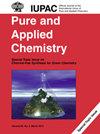用脱气活性炭去除废水中的酸性染料;酸性黄 25 和酸性红 4
IF 2
4区 化学
Q3 CHEMISTRY, MULTIDISCIPLINARY
引用次数: 0
摘要
在 300 °C 和 600 °C 下制备活性炭,并通过扫描电镜、电子衍射X射线和X射线衍射对其进行表征,然后将其用作去除酸性染料(酸性黄 25 和酸性红 4)的吸附剂。为了估算动力学和平衡参数,采用了一些动力学和等温线模型。在最初的 15 分钟内,染料以较高的速率吸附在活性炭表面,之后染料开始向微孔扩散,吸附过程趋于稳定。根据一阶和二阶动力学模型估算了速率常数。酸性红 4 和酸性黄 25 的最大吸附容量分别为 526.32 毫克/克和 555.55 毫克/克。记录到的焓变值为:酸性黄 25 吸附 19.44 kJ mol-1,酸性红 4 吸附 16 kJ mol-1,这意味着吸附过程是内热的。在测试温度下,酸性红 4 和酸性黄 25 的吉布斯自由能变化(-393.28, -1,515.48, -2,634.68 J mol-1)为负值(-251.72, -1,058.06, -2,367.84 J mol-1),这证实了吸附过程的可行性和自发性。正如粒子内扩散模型的线性图所示,碳表面对染料的吸附是一个扩散控制过程。本文章由计算机程序翻译,如有差异,请以英文原文为准。
Removal of acidic dyes; acid yellow 25 and acid red 4 from wastewater by degassed activated carbon
Activated carbon was prepared at 300 °C and 600 °C, characterized by SEM, EDX and XRD, and was then used as an adsorbent for the removal of acidic dyes; acid yellow 25 and acid red 4. The activated carbon prepared at high temperature (600 °C) due to its high carbon contents and surface area was subsequently used as adsorbent for the selected dyes adsorption using batch adsorption approaches to estimate different adsorption parameters. For the estimation of kinetics and equilibrium parameters a number of kinetics and isotherm models were employed. Dyes were adsorbed on activated carbon surface at a high rate for the first 15 min, after which it began to diffuse into the micro pores and thus the process became steady. The rate constant was estimated for first and second order kinetics models. The maximum adsorption capacities recorded were 526.32 mg g−1 for acid red 4 and 555.55 mg g−1 for acid yellow 25. The enthalpy change values recorded were; 19.44 kJ mol−1 for acid yellow 25 adsorption and 16 kJ mol−1 for acid red 4 adsorption, meant that the process is endothermic. The negative values of Gibbs free energy change (−393.28, −1,515.48, −2,634.68 J mol−1 ) of acid red 4 and acid yellow 25 (−251.72, −1,058.06, −2,367.84 J mol−1 ) at tested temperatures, confirmed the feasibility and spontaneity of the adsorption processes. The adsorption of dyes on the carbon surface was diffusion-controlled process, as demonstrated by the linear graph of intraparticle diffusion model.
求助全文
通过发布文献求助,成功后即可免费获取论文全文。
去求助
来源期刊

Pure and Applied Chemistry
化学-化学综合
CiteScore
4.00
自引率
0.00%
发文量
60
审稿时长
3-8 weeks
期刊介绍:
Pure and Applied Chemistry is the official monthly Journal of IUPAC, with responsibility for publishing works arising from those international scientific events and projects that are sponsored and undertaken by the Union. The policy is to publish highly topical and credible works at the forefront of all aspects of pure and applied chemistry, and the attendant goal is to promote widespread acceptance of the Journal as an authoritative and indispensable holding in academic and institutional libraries.
 求助内容:
求助内容: 应助结果提醒方式:
应助结果提醒方式:


